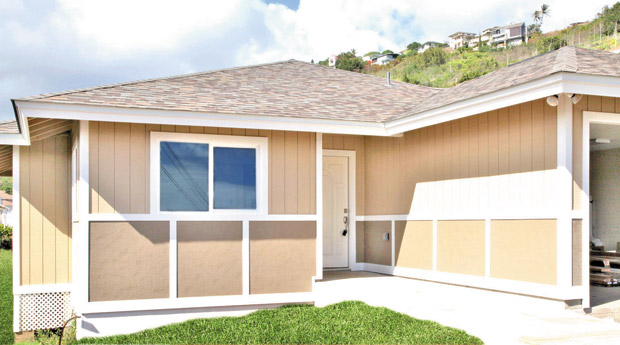 The Great Wall of China, constructed from stone, brick, wood and other materials, collectively spans about 13,171 miles along China’s northern borders and was built over 20 centuries. Hawaii has its own great wall to claim, the Great Single Wall, though these residential walls were built to store belongings and shelter families from weather, not deter marauding invaders. Single-wall homes were the go-to method of home construction from the 1940s to the late 1970s, when building codes were updated, only permitting double-wall construction.
The Great Wall of China, constructed from stone, brick, wood and other materials, collectively spans about 13,171 miles along China’s northern borders and was built over 20 centuries. Hawaii has its own great wall to claim, the Great Single Wall, though these residential walls were built to store belongings and shelter families from weather, not deter marauding invaders. Single-wall homes were the go-to method of home construction from the 1940s to the late 1970s, when building codes were updated, only permitting double-wall construction.
While all the single walls in Hawaii might not equal the length of the Great Wall, single-wall houses remain as ubiquitous in Hawaii as teacups are in China. Many Hawaii residents grew up in one and recall with a sense of nostalgia the redwood tongue and groove siding that made it easy to pin up surf posters and stickers. They will also laugh at the memory of overheard conversations and muffled bathroom sounds emanating through a mere 3/4-inch of wood separating the rooms. How did these houses survive decades of tropical weather, termites and abuse from rambunctious youth and clawing pets?
Buying a circa-1950s single-wall home presents challenges that new homeowners need to prepare themselves for. Thinking of building an extension or going up? Not so fast. All new construction must conform to current building codes requiring double-wall construction, structural connectors and more substantial foundations.
“Second-floor additions have to be supported by heavy masonry or concrete columns,” said president of Graham Builders Evan Fujimoto. “Single-wall structures offer little lateral resistance and cannot support heavy loads. Masonry columns are typically built on the outside of the house to support large second floor beams and girders spanning over the existing roof, if the pitch is low enough. Wood posts are installed inside to reduce the spans of those beams. It’s like a 3-D puzzle figuring out how you’re going to support a large addition over a single-wall house.”
New footings also have to be poured inside the house to support posts, which entails saw-cutting, jackhammering and hand excavation — messy, noisy, dusty and sweaty work. “Everyone’s favorite part of the job,” Fujimoto quipped.
Tying the knot — when single wall meets and marries double wall — is where the ar t of renovation comes into play. “This gets tricky for designers and builders because you’re combining two very different structural systems with their own unique aesthetic,” Fujimoto explained. “Some rooms end up with tongue and groove still in place, but new drywall surfaces appear, so balancing these finishes takes some finesse.”
Homeowners interested in learning more about how to tackle additions to single-wall houses or building new can attend Graham Builders’ upcoming “Building Your Home for Life” seminar. Seminars are free. To register, visit grahambuilders.com or call 593-2808.
FREE SEMINAR
Building Your Home for Life
Aug. 27, 9 a.m.
Honolulu Country Club
GRAHAM BUILDERS
contact // 593-2808
web // grahambuilders.com
See more articles from: Graham Builders